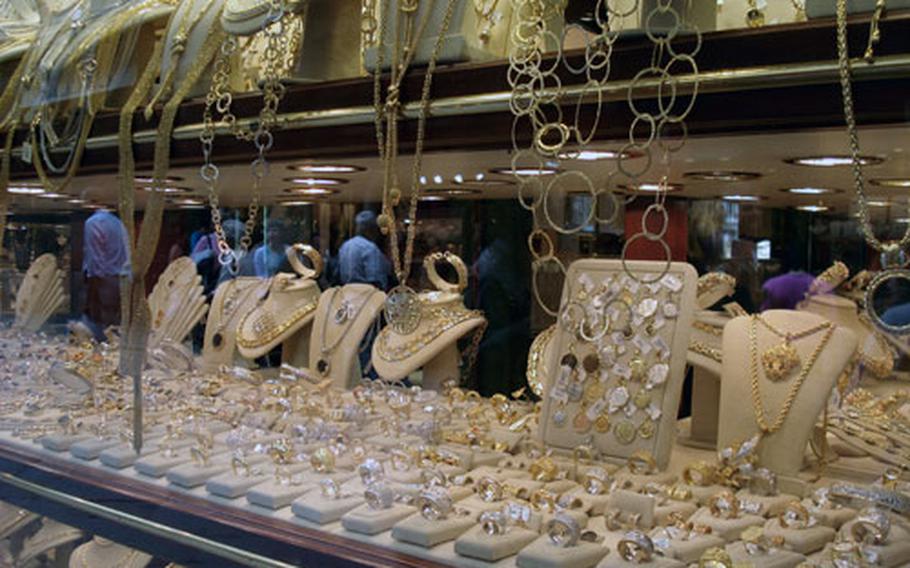
Leather is not the only shopping draw in Florence. The gold market is yet another attraction for tourists visiting Florence and its shops like this one nestled into small buildings on the Ponte Vecchio. (Sandra Jontz / S&S)
Florence is famous for bistecca alla fiorentina and all the other cuts of beef served up in its restaurants. So it seems only logical that the Italian city should have something else it is well known for: a booming leather market.
But surprisingly, most of the hide on display in Florence’s leather bazaar — an overwhelming selection of jackets, coats, purses, shoes, belts, laptop cases and gloves — actually doesn’t hail from the region of Tuscany, of which Florence is the capital. Shops and artisans import their rawhide from distant places, such as northern and southern Africa, Australia and Syria, according to owners of several stalls and stores that crowd the market just a few blocks from another landmark, the Duomo, the city’s cathedral.
The hides come in raw, and skilled workers in factories throughout Florence take the pelts and treat them, dye them an array of stunning colors and hand-craft the merchandise, ranging from form-fitting crop jackets to stunning handbags, ankle-length coats, ankle-wrap sandals and more.
Florence even has its own school of leather, or Scuola del Cuoio, in the Monastery of Santa Croce. The school was created, according to its Web site, after World War II so Florentine leather artisans could put their talents to use, and give war orphans a way to learn a practical trade and earn a living.
It’s a working school, where students learn how to make leather garments, purses, and accessories — conveniently sold on the premises. It is the "largest genuine laboratory in the city where clients can watch the artisans create the leather goods in the midst of centuries-old history," the site states.
The showroom and laboratory are open to the public and tourists can watch a variety of goods being produced, said Laura Gori, a school administrator. All staff members speak English. Entering the school through the Santa Croce church will cost 5 euros. But entering directly from Via San Giuseppe, 5R, is free.
Then as you tour the city full of breathtaking works of art, peek into the numerous Fiorentine pelletterie, the leather shops that push their super-soft leather goods. They abound throughout the city, so if you move away from the main attraction areas bursting with tourists, you could save money on the leather ware and accessories.
Those looking for a super-steal on a leather treasure made of sheep or cow or snake hide should not be daunted by the price tag. Keep in mind that haggling in Italy (for the most part) is not only tolerated, it’s expected. The practice is a challenge for the shopper to try to work out a better deal, and a bit of a mind-game on the part of the vendor, who will come away with a feeling of having bestowed a great product on a worthy customer for a good price.
Ask the clerk if that’s the final price and work from there. This is definitely the case at the leather market, and sometimes even works in stores that might be willing to give a discount.
In one shop, for example, a jacket tagged with a ticketed price of 430 euros wasn’t the final offer. Minor haggling brought it down to 230 euros.
Still, tourists who earn their salaries in U.S. dollars have another aspect to consider: the weak dollar-to-euro exchange rate might not make the new-found product such a steal in the end.